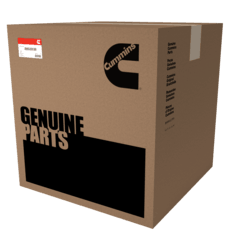This truck part is made by Cummins®. We guarantee that all of our parts are from the OEM (original equipment manufacturer), ensuring a proper fit and quality manufacturing.
We honor the warranty provided by the original equipment manufacturer.
Introduction
The Cummins 187863 Oil Seal is engineered to ensure the efficient operation of commercial trucks by preventing lubricant leakage, thereby maintaining the integrity of the engine or transmission system. This part is essential for the smooth functioning and longevity of the vehicle.
Basic Concepts of Oil Seals
An oil seal, also known as a rotary shaft seal, is a mechanical device designed to prevent the leakage of lubricants from rotating shafts. It creates a barrier between the rotating and stationary parts of a machine, retaining lubricants within the system while excluding contaminants. This preservation of system efficiency and reliability is critical for the operation of vehicles 1.
Purpose of the Cummins 187863 Oil Seal
This Cummins part is specifically designed to seal the interface between rotating and stationary components within the engine or transmission. Its placement, typically around shafts where movement occurs, ensures that lubricants remain within the system, preventing performance degradation or damage 2.
Key Features
The Cummins 187863 Oil Seal is characterized by its material composition, often including synthetic rubber compounds for flexibility and durability. Its design incorporates a spring element to maintain contact pressure against the shaft, ensuring a consistent seal. It may also feature anti-rotation devices to prevent twisting during operation, enhancing performance and reliability 3.
Benefits of Using the Cummins 187863 Oil Seal
Utilizing this part offers several advantages, including improved sealing efficiency, reducing the risk of lubricant leakage. Its design contributes to the longevity of the seal, offering extended service life under various operating conditions. Furthermore, by maintaining system integrity, it plays a role in the overall reliability of the truck’s engine or transmission system.
Installation Considerations
Proper installation of the Cummins 187863 Oil Seal is vital for its optimal performance and longevity. Guidelines suggest ensuring the mating surfaces are clean and free from imperfections before installation. The seal should be seated correctly within its housing, with attention paid to alignment and the application of any necessary lubricants to facilitate installation and operation.
Troubleshooting Common Issues
Typical problems associated with oil seals include leaks, which can arise from wear, improper installation, or contamination. Diagnosing these issues involves inspecting the seal and its surroundings for signs of damage or misalignment. Recommended solutions may include cleaning the area, replacing worn seals, or addressing any underlying causes of seal failure.
Maintenance Tips
Routine maintenance practices can prolong the life of the Cummins 187863 Oil Seal and ensure continued efficient operation. Regular inspections for signs of wear or damage are recommended. Additionally, maintaining clean operating conditions and adhering to scheduled maintenance intervals can help prevent issues related to seal performance.
Cummins Overview
Cummins Inc. is a global power leader that designs, manufactures, and distributes engines, filtration, and power generation products. With a history spanning over a century, Cummins has established a reputation for quality and reliability in the commercial truck industry, offering a wide range of products designed to meet the demanding requirements of heavy-duty applications.
Understanding the Role of Part 187863 Oil Seal in Engine Systems
187863, an oil seal, is integral to maintaining the efficiency and longevity of various engine components. Its primary function is to prevent oil leakage while allowing smooth operation of moving parts. Here’s how it interacts with specific components:
Crankshaft Seal
The crankshaft seal, where 187863 is often installed, plays a significant role in sealing the interface between the crankshaft and the engine block. This seal ensures that lubricating oil remains within the crankcase, preventing it from escaping into other areas of the engine. By maintaining proper oil levels, the seal helps in reducing friction and wear on the crankshaft journal and main bearings. Additionally, it protects the crankshaft from contaminants that could otherwise enter the crankcase, ensuring optimal performance and durability of the crankshaft.
Conclusion
The Cummins 187863 Oil Seal is a critical component in the maintenance and operation of commercial trucks. Its role in preventing lubricant leakage and protecting engine components underscores its importance in ensuring vehicle performance and longevity. Proper installation, maintenance, and understanding of its function are essential for maximizing the benefits of this part.
SPECIFICATIONS
RECOMMENDED PARTS
* Variable geometry turbocharger and electronic actuator repairs are not eligible to be claimed as over-the-counter under New or ReCon parts warranty for parts installed after October 1, 2018.
* Diesel Oxidation Catalyst (DOC), Diesel Particulate Filter (DPF), Selective Catalyst Reduction (SCR) catalyst, and Electronic Control Module (ECM) repairs are not eligible to be claimed as over-the-counter under New or ReCon parts warranty for parts installed after January 1, 2020.
* These restrictions are only applicable to New parts and ReCon parts coverages for the components listed above sold to a customer in the US or Canada. All other coverages are excluded. All other regions are excluded.

